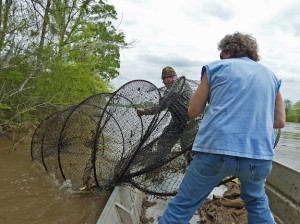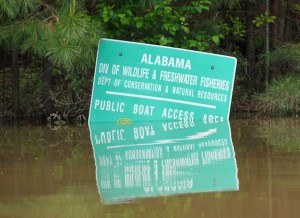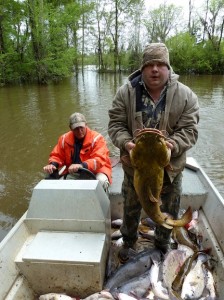Rising Tombigbee does not deter local fishermen

With six feet of water covering the parking lot at the Tuscahoma Landing boat ramp, Phillip Roberts and James Hall didn’t hesitate to adjust. The road leading down the hill toward the Tombigbee River became the makeshift ramp for the Roberts’ custom-built aluminum boat made specifically for the task ahead – running hoop nets.
Roberts said their hoop netting is a tribute to the past when the folks along the river scraped by on whatever they could do to put food on the table. In the 20th century in rural Choctaw County, if you didn’t cruise, cut or haul timber, the choices were somewhat limited.
“This is a Choctaw County tradition that is dying out,” said the 44-year-old Roberts. “Back in the day, they either had to run moonshine or run hoop nets.”
Roberts said James Hall, Walter Wayne Hall and Connie Littlepage introduced him to net fishing, and he’s learned from them all.
“James’ daddy did it,” Roberts said. “That’s the way his daddy fed him. It’s important to him. C.A. Ezell (Ezell’s Fish Camp founder) used to run hoop nets for his commercial business. When they got out of it, they had a bunch of old hoop nets in a barn. So we started using them to fish with.”

The Tombigbee River was high enough recently to submerge the parking lot and boat ramp at Tuscahoma Landing.
Although both Roberts and Hall have commercial fishing licenses, a requirement to fish with hoop nets, neither has to do it to feed their families.
“We catch all we want,” Roberts said. “We don’t sell them. We fill our freezers and then give them away. We give them to people for birthdays or some other reason to have a fish fry. We’ve got a friend who is fixing to retire from the (paper) mill, so we’re giving them the fish for the retirement party. I just really get a kick out of running hoop nets.”
Roberts, who has worked in oil fields all over the world for the last 25 years, said timing is the key for setting hoop nets successfully.
“What we do is wait until the springtime to do our fishing,” he said. “That’s when the fish go up the rivers to spawn, and they run the banks. They run the banks for two reasons, to get out of the current and to feed. All your baitfish, the minnows and shad, are in the bushes or running the bank.
“When we set our nets, we want a good bank where there are not a lot of trees where your nets will get hung. You want a place with current, but you don’t want any eddies. If the water eddies, it will make your net fold up. We tie the head line to a tree or something. Then we put a float on the tail line. It’s just easier to grab the line that way. Some people will anchor the tail line and use a drag to find the line. That’s a lot of trouble, which is why we use floats.”

Roberts said the equipment is very important for a successful trip. A reliable outboard with a wide, sturdy boat are essentials. Boat positioning is important as well. During our trip last week, Hall was at the helm and all his focus was putting the boat in the right place with the high-water conditions.
“If you noticed, when we were running the nets, James never let the boat get sideways to the current,” Roberts said. “If you do, the current’s got you. You’ve got to keep the boat pointed pretty much into the current. When I grabbed the net, I would turn the boat back toward the river so Mr. James could keep control of the boat.”
Once the tail line is grabbed and the first hoop comes to the surface, there is no time for hesitation, Roberts said.
“You’ve got to go with it,” he said. “You’ve got to put it in the boat. If you don’t, you can tear a hole in your net or put somebody in the river. When you’ve got the net in your hands, you’ve got to commit to putting the net in the boat. If you don’t, you’ve got to let the net go. It’s too dangerous.”
That’s especially important if the net is full of fish, which can happen at any time.
“We’ve caught about 500 pounds in one net before,” Roberts said. “That was a job, but you’ve just got to bow up and get it in the boat.”
The contents of each net are pretty much like Forrest Gump’s box of chocolates.
“When you start running nets, you don’t know what you’re going to catch,” Roberts said. “When I started this spring, the water was real cold. There wasn’t much of anything running. I caught a few catfish, but not many. When the sun started warming the water, I started catching catfish. The other day was the first time I’d caught any drum.
“I think that when the water gets a certain temperature, the catfish start running. When the water gets a little warmer, the scale fish (drum, buffalo, carp, etc.) start running.”
When the fish really start running, Roberts and Hall have to be careful about the number of nets they’ve got out.
“What we’re doing is just for fun,” Roberts said. “If we did it any more, it’d be too much like work. But I do have people I can call and say, ‘Hey, I’ve got a bunch of fish,’ and they will come and help. I give them fish for helping me.”
Roberts said the best way to learn to fish the rivers is to find mentors who have been doing it for a while.
“I like fishing with the older folks,” he said. “I learned from them by soap-fishing on trotlines and hoop netting. And I didn’t just learn from one man. I took what all of them taught me and combined it. Everybody has their own way of doing things. There are always different methods.”
One of the nine nets we ran last week had three hybrid striped bass, including one nice one, heavier than 10 pounds. They were quickly thrown back into the swift, muddy water.
“If we catch any game fish (bass, bream, crappie, etc.) they go right back in the water,” Roberts said. “It’s against the law to keep any game fish.”
Also, current regulations limit the retention of large catfish. One catfish over 34 inches in total length is allowed per fisherman per day.
The one thing Roberts doesn’t have in his boat is a scale, so he doesn’t know exactly how heavy the fish are that come into the boat.
“Just guessing, I’d say we’ve caught blue cats between 80 and 90 pounds,” he said. “We’ve caught yellow cats between 70 and 80 pounds.”
Last week, we had a yellow (flathead) catfish that was somewhere in the mid 30s with a couple of blue cats that were pushing 30 pounds.
From my experience, the flavor of a large flathead doesn’t get too strong. On the other hand, a large blue cat must be properly cleaned and some meat discarded. On the larger fish, Roberts and his cleaning crew will cut the tail off to get the blood out while it’s being skinned.
“When you filet a blue cat, you’ve got to trim off all the fat and the red meat,” Roberts said. “Once you get that done, it has a red line that goes right down the center. You’ve got to cut all that red meat out. If you do that, all you have to do then is fry it up.”
David Rainer is a weekly columnist for OutdoorAlabama.com.
